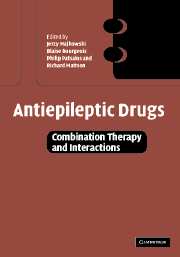Book contents
- Frontmatter
- Contents
- List of contributors
- Foreword
- Foreword
- Acknowledgements
- Part I Introduction
- Part II Pharmacokinetic interactions
- Part III Pharmacodynamic interactions
- Part IV Drug interactions in specific patient populations and special conditions
- Part V Conclusions and future perspectives
- 23 Selection of drug combinations in clinical practice: current and future perspectives
- 24 Future research: an experimental perspective
- 25 Future research: a clinical prospective
- Index
23 - Selection of drug combinations in clinical practice: current and future perspectives
from Part V - Conclusions and future perspectives
Published online by Cambridge University Press: 07 September 2009
- Frontmatter
- Contents
- List of contributors
- Foreword
- Foreword
- Acknowledgements
- Part I Introduction
- Part II Pharmacokinetic interactions
- Part III Pharmacodynamic interactions
- Part IV Drug interactions in specific patient populations and special conditions
- Part V Conclusions and future perspectives
- 23 Selection of drug combinations in clinical practice: current and future perspectives
- 24 Future research: an experimental perspective
- 25 Future research: a clinical prospective
- Index
Summary
Introduction
Polytherapy has flourished in the long history of epilepsy. In recent decades, it has waxed and waned depending on our current knowledge and availability of antiepileptic drugs (AEDs). Introduction of effective AEDs in the first half of the twentieth century shifted treatment strategy towards monotherapy in the 1950s and 1960s. However, in the 1960s and 1970s, when carbamazepine (CBZ), valproic acid (VPA), benzodiazepines and other AEDs made their appearance, treatment reverted towards polytherapy once again. The concept of treatment was based on the erroneous assumption that polypragmasy improves the effectiveness of AEDs without increasing their toxicity. Besides, clinical trials of AEDs were biased and methodologically dubious (Coatsworth, 1971).
Introduction of double-blind trials and other rules for drug evaluation protocols was an important step in comparative and more objective AED clinical evaluation (Delgado-Escueta et al., 1983; Mattson et al., 1983). Moreover, when the negative aspects of polytherapy were reported in the 1970s and 1980s (Shorvon and Reynolds, 1979; Reynolds and Shorvon, 1981), there was a return to monotherapy in the majority of patients. Tests of AED concentration in the blood serum and credibility of the measurements substantially contributed to this shift in treatment strategy (Pippenger et al., 1976; Richens, 1980).
In the late 1980s and in the 1990s several new AEDs were introduced to the pharmaceutic market and used as add-on therapies. This led to yet another shift towards polytherapy in difficult-to-treat patients.
Keywords
- Type
- Chapter
- Information
- Antiepileptic DrugsCombination Therapy and Interactions, pp. 421 - 440Publisher: Cambridge University PressPrint publication year: 2005



